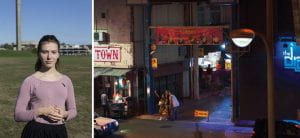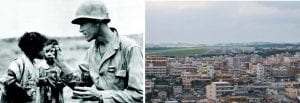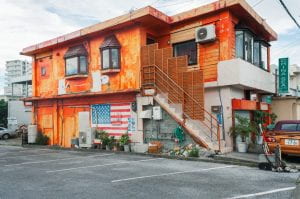Research in Photojournalism
A Photo-journalistic Journey into Okinawa
By Lizzy Santoro
I am a dual major in Photography and Political Science. My passion for social and political issues always compliments my artistic side. In summer 2016 I received an OUR summer grant to study the culture of the American military community of Okinawa, Japan. My decision to do a photo-journalistic research in Okinawa was motivated by a personal experience. My journey began when I joined an Okinawan martial arts dojo, Kodokai, seven years ago. My Sensei is a Marine Corps veteran who was stationed in Okinawa during the seventies and learned martial arts during his time there. He truly immersed himself in the culture and became versed in the conflict between the Okinawans and American military. By going to the dojo five days a week, three/four hours a day, for seven years I, too, learned about the culture and the relationship between the American military and Okinawa.

Left: Portrait of Santoro at UMass Dartmouth quad; right: Santoro’s photograph of two Okinawans taking a selfie with an American at Gate Two street in Okinawa, 2016.
There are 5 times as more American bases in Japan than in Afghanistan and 75% of those bases are located in just 0.6% of Japan’s landmass, on the island of Okinawa. This over-saturation of American military on a very small landmass has affected the area in a large number of tangible ways- both positive and negative. Okinawa’s economy, culture, and history have been strongly influenced by America; conversely, thousands of Americans have been shaped by the Okinawan culture and society.

Left: American soldier shares rations with Okinawan children in 1945; right: Santoro’s photograph of the Osprey helicopters on Futenma Air Base, 2016.
§
In my recent travel, I did my best to tell the story of the American military presence in Okinawa through both texts and images. I took notes as I explored different places. I interviewed both Americans and Okinawans. I did research on my own and I captured the culture, utilizing the elegance of the frozen moment that only photographs can provide. It is important to note that my photographs are not just representations of reality; they are mediated images with deep meanings. Indeed, I did my best to capture important moments and locations and I “framed” these moments and locations in meaningful ways. Even though the final product–an illustrated book–ended up being not too long, it definitely proved to be very challenging. The recent history of Okinawa is incredibly complicated. It includes 70 years of injustice and Okinawan bitterness at both the Japanese and the American central governments. At the macro level, there are fierce political debates about how necessary the bases are in Okinawa, whether the Okinawan people have been subjugated by American and Japanese superpowers, and whether the bases do more harm than good. But there is also a less polarized micro reality. Most Americans are just doing their jobs. They were given relatively no choice to be stationed in Okinawa and are just fulfilling their duty as honorably as possible. Simultaneously, most Okinawans are just living their daily lives as best as they can, and as harmoniously as possible with their American neighbors.

Santoro’s photograph of a neighborhood near the American base, 2016. American iconography and English Signage are fairly common throughout Okinawa, but they are especially prevalent near the bases.
§
There were more challenges than just the complexity of my research topic. I struggled particularly with the writing portion of this project because my upbringing put me on both sides of this debate. I grew up in a military family, with a father who was a Naval Commander and a brother training to be a Marine Corps officer. On the other hand, I have strong personal relationships with several people who are somewhat critical of the American military presence in Okinawa. The only way I could navigate through these conflicting emotions was to tell the story as historically accurate as possible. The result of this strategy is a book that is as removed from myself as I could manage; however, the origins of this book could not have been more personal because, for me, this research project is about a place where my second home was conceived. To read my book and to see more of my photographs, please click on the book’s cover:


